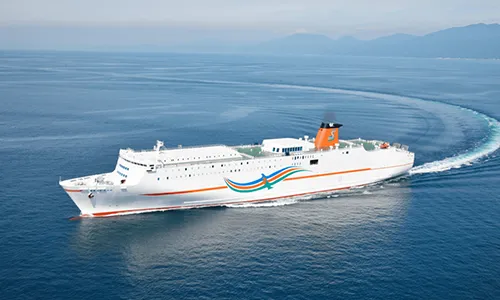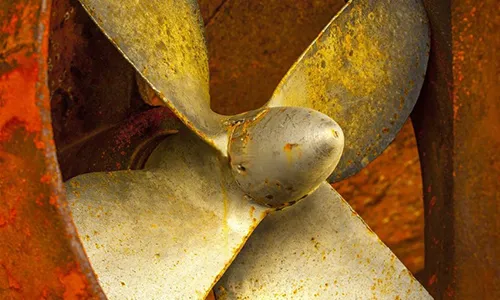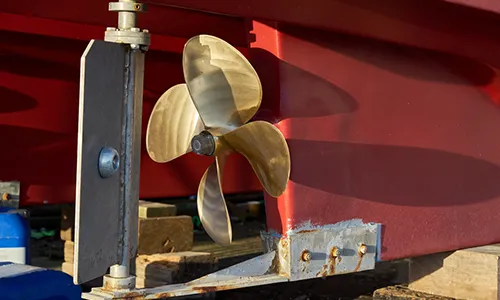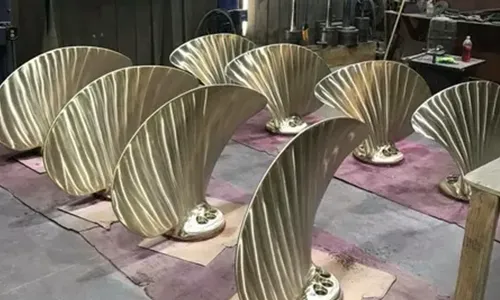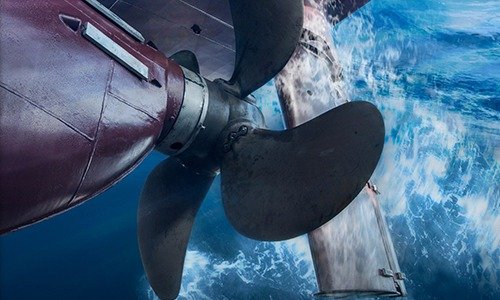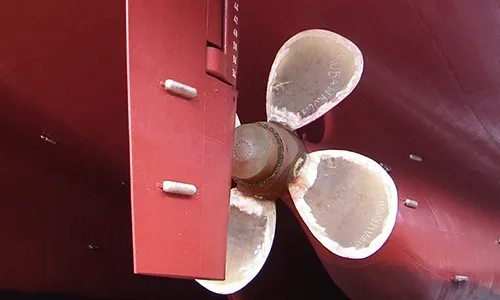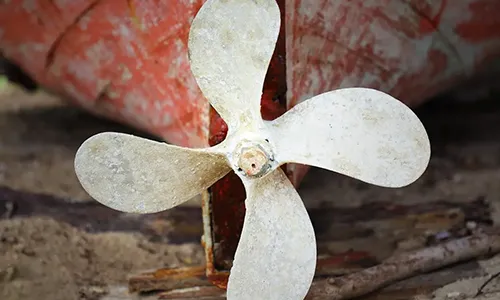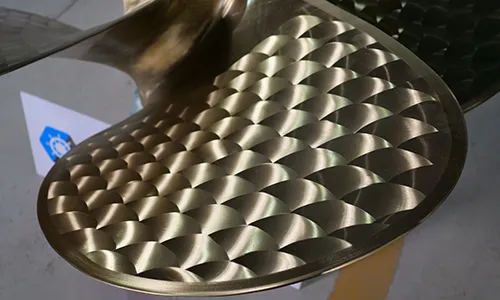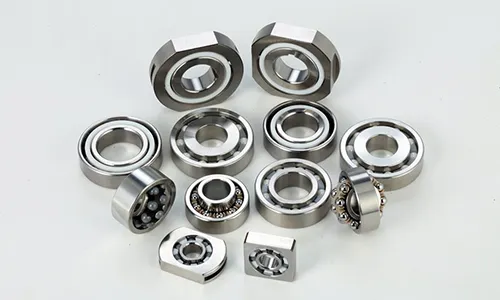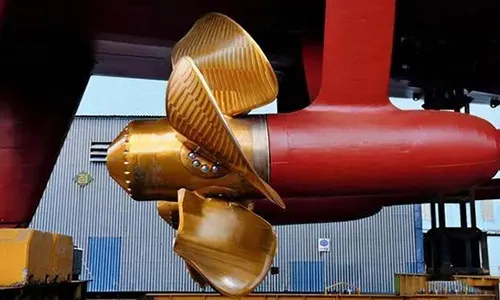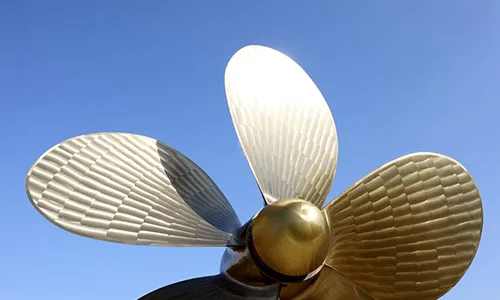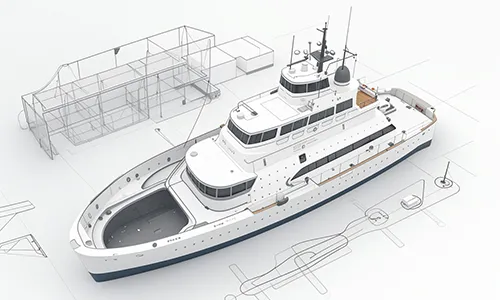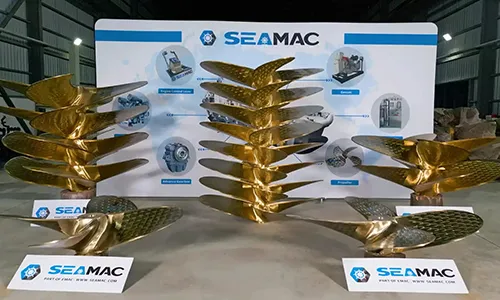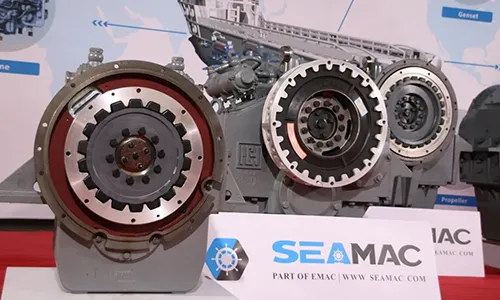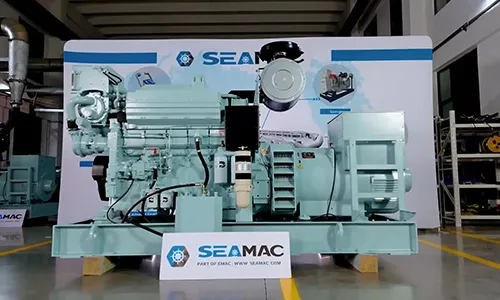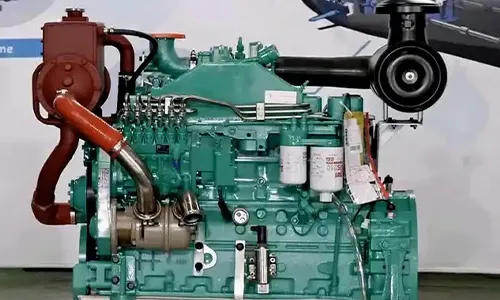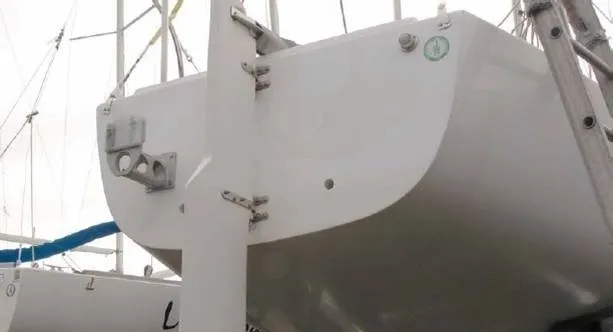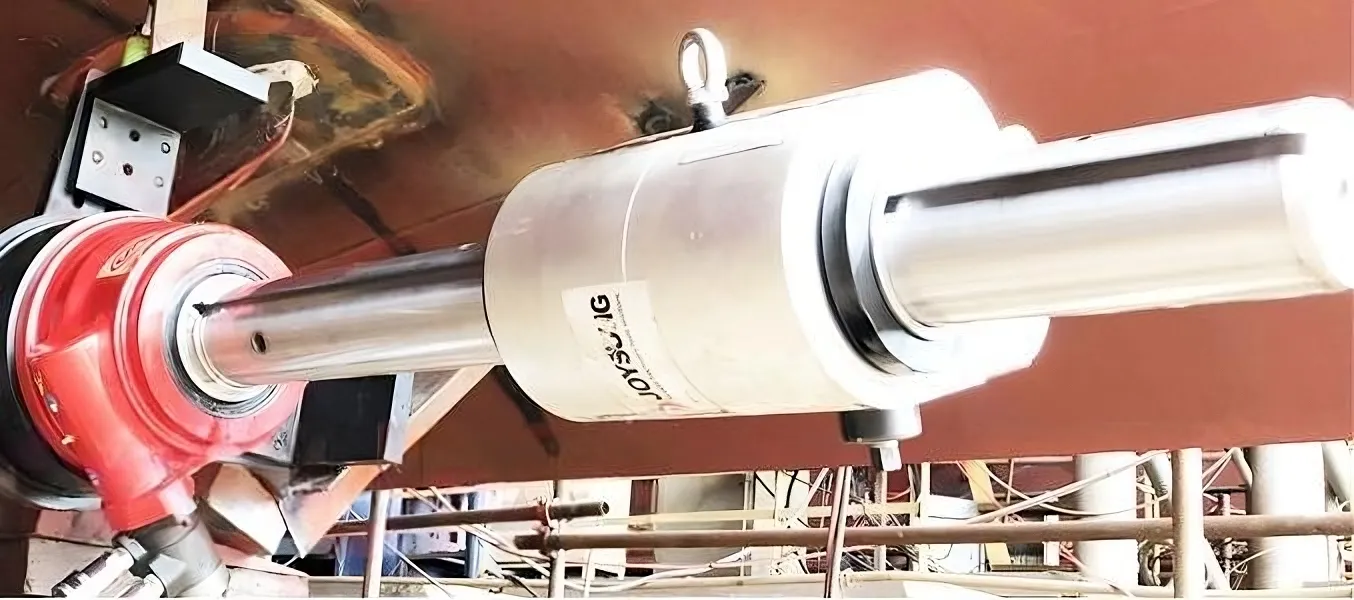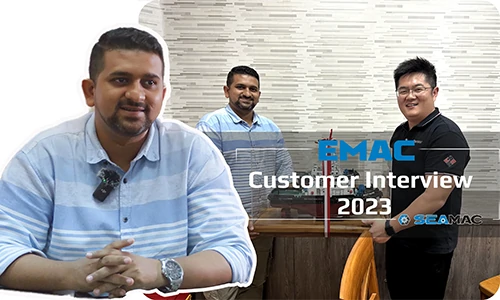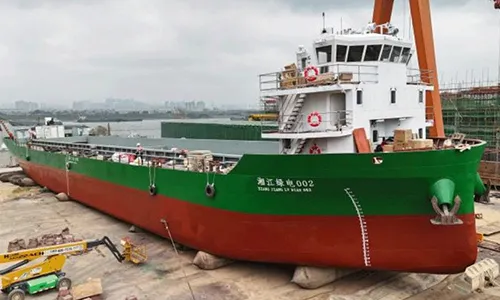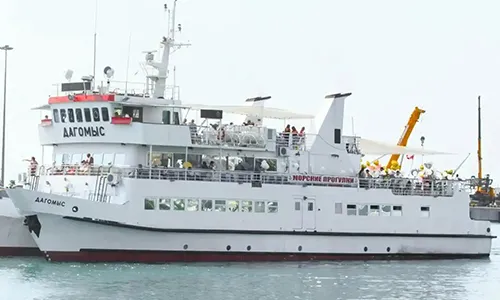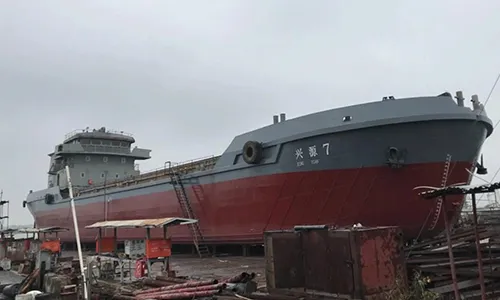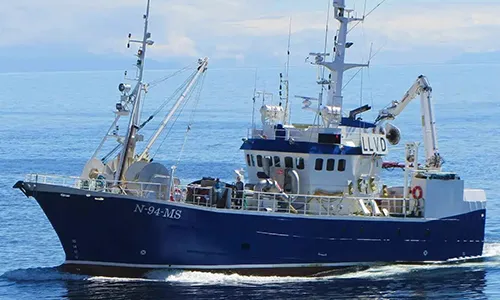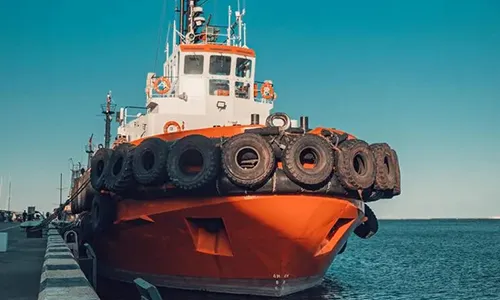Contra-Rotaing Propeller
DCEC B5.9CMII-GM series marine auxiliary engine is a 6-cylinders in line, 5.9 liters four-strokes engine with 102mm bore and 120mm stroke. Equipped with BYC fuel pump. The prime power range of DCEC B5.9CMII-GM series marine auxiliary engine is 100 kW to 115 kW.
DCEC marine auxiliary engines have different configurations which have different power output. DCEC provides both heat exchanger cooling and radiator cooling marine auxiliary engines, which mainly using for marine main generator and marine emergency generator. For the emergency generator set applications, we provide additional options for customers such as dual starter motor system (we provide both electric and spring starter motor for customers), which are required by most of international classifications. All of DCEC marine auxiliary engine are comes with dry type exhaust system, which means dry type exhaust manifold and dry type turbocharger, SeaMac provides upgrading services for water-cooled exhaust system, which modify dry type exhaust system into water-cooled exhaust system, which are quite important and often requested by passenger boat projects.
General Specifications of Contra-Rotaing Propeller
| Engine Type: | 6 Cylinders |
| Displacement: | 5.9 L |
| Bore * Stroke: | 102 mm*120 mm |
| Advertised Power: | 100 – 115 kW @ 1500 RPM |
| Peak Torque: | 636 – 732 N.m @ 1500 RPM |
| Rated Speed: | 1500 RPM |
| Emissision: | N/A |
| Aspiration Method: | Turbocharged/Aftercooled |
| Wet Weight: | 543 kg |
| Dimission Standards: | N/A |
| DCEC B5.9CMII-GM Marine Auxiliary Engine Catalogue | |||||||
Engine Model | Rated Power | Aspiration | Engine Model | Rated Power | Aspiration | ||
| B5.9CMII136G | 100 kW @ 1500 RPM | Turbocharged/Aftercooled | B5.9CMII156G | 115 kW @ 1500 RPM | Turbocharged/Aftercooled | ||
| ——END—— | |||||||
Contra-Rotaing Propeller
This list including all models of Contra-Rotaing Propeller.
Click here to find Contra-Rotaing Propeller by type (Fuel System & Power Range).
Multi-Fuel Engine Debuted in North America
Cummins recently announced that it will display a new generation of 15-liter heavy-duty multi-fuel engine platform during the Las Vegas Construction Machinery Expo (Con Expo, referred to as: North America Exhibition) from March 14th to 18th to meet North American non-road Tier 5 emission standards, providing OEMs with the opportunity to accelerate the decarbonization of heavy-duty off-highway applications.
Zero-carbon Brand Makes its Debut in North America
On the first day of the North American exhibition (CONEXPO CON/AGG) on March 14, Cummins made its debut with the Accelera zero-carbon brand, reaffirming that “zero emission” is the top priority of Cummins’ development, and promised to achieve the goal of zero carbon by 2050
SEMA has Discovered the “Mad Max” Pickup Truck!
Therefore, the car’s doomsday modification style is also inherited from the legendary experience of the car, and the car is named “Chain Smoker”. The whole car is toned based on rust and patina, and many parts of the body are bundled with scrap iron chains to highlight…
Thailand | Pump
EMAC’s customer interview video of 2023, EMAC finished a series of customer interview with 10 different business partners from different countries and regions, most of videos are took at customer’s company and factory, collecting all reviews and evaluations of EMAC, covering different industries in different country and regions, we believe this series of EMAC customer interview videos can help all of other customers get to know more about EMAC, our true customer interview case can greatly help customers relieve their worries, and build their confidence to cooperate with EMAC.
A Promise is A Promise, EMAC always do what we say, and for customer’s feedback, also 100% original from clients’s real words. EMAC, a Chinese company that you can trust!
The 8 Largest Ship Propellers in History
Ship propellers are the unsung heroes of maritime engineering, driving some of the world’s most iconic vessels. From container ships like Emma Maersk to legendary ocean liners like the Titanic, these colossal propellers have played a crucial role in shaping maritime history. Each of these massive propellers represents a unique engineering achievement, optimizing propulsion, maneuverability, and fuel efficiency.
How Propeller Pitch and Diameter Affect Ship Performance
Propeller pitch and diameter are critical factors influencing a ship’s speed, fuel efficiency, and maneuverability. A higher pitch increases speed potential but demands more engine power, while a lower pitch enhances acceleration and control. Similarly, a larger diameter generates more thrust and improves efficiency at lower RPMs, whereas a smaller diameter suits high-speed vessels but may increase cavitation. Selecting the right propeller configuration ensures optimal performance, balancing power usage and operational needs. Regular inspections and adjustments help maintain efficiency, reduce fuel consumption, and extend the lifespan of propulsion systems.
Fatigue Crack Detection in Marine Propellers
Fatigue cracks in marine propellers develop due to cyclic hydrodynamic stresses, cavitation, corrosion, and operational conditions. Detecting these cracks early is crucial for maintaining efficiency, preventing failures, and reducing repair costs. Common non-destructive testing (NDT) methods include visual inspection, dye penetrant testing (DPT), magnetic particle inspection (MPI), ultrasonic testing (UT), eddy current testing (ECT), and radiographic X-ray inspection. Regular inspections, proper handling, and real-time monitoring help extend propeller lifespan and ensure safe vessel operation. Implementing these best practices enhances propulsion efficiency and reduces unexpected downtime.
Best Practices for Storing Spare Ship Propellers
To prevent aging of spare ship propellers, they must be cleaned, stored in a dry and stable environment, positioned correctly, coated with protective layers, and regularly inspected. Proper storage minimizes corrosion, mechanical stress, and environmental damage, ensuring the propeller remains in optimal condition for future use. By following these guidelines, ship operators can maximize the reliability and lifespan of their spare propulsion components.
How to Determine if a Ship Propeller Blade Angle is Correct
The blade angle of a ship’s propeller significantly affects thrust, fuel efficiency, and mechanical load. To determine if the angle is correct, methods such as visual inspection, fuel efficiency monitoring, cavitation analysis, and sea trials can be used. Fixed-Pitch Propellers may require re-machining if the angle is incorrect, while Controllable-Pitch Propellers can be adjusted through hydraulic systems. Regular maintenance and proper calibration ensure optimal performance and longevity of the propulsion system.
Maintenance and Inspection of Marine Propeller Lubrication Systems
The lubrication system of a marine propeller plays a key role in reducing friction, preventing corrosion, and ensuring smooth propulsion. Regular maintenance includes checking oil quality, inspecting stern tube seals, monitoring system pressure, and preventing water contamination. Common issues such as oil leakage, overheating, and misalignment can be prevented through proactive inspections and timely repairs. Proper lubrication system management enhances vessel efficiency, reduces operational costs, and prolongs the lifespan of propulsion components.
How to Reduce Propeller Drag and Improve Ship Speed
Excessive propeller drag can hinder ship speed and fuel efficiency. Factors such as marine fouling, cavitation, blade design, propeller-hull mismatch, and shaft misalignment contribute to increased resistance. Effective measures to reduce drag include regular cleaning, optimized blade design, cavitation prevention, better propeller-hull integration, and stable shaft maintenance. By applying these techniques, ship operators can enhance propulsion efficiency, reduce fuel consumption, and improve overall vessel performance.
Understanding Ship Shafting Systems and Their Key Components
The shafting system is essential for transferring power from a ship’s engine to its propeller, ensuring efficient propulsion. It includes key components such as the hydraulic nut, propeller, nozzle, stern tube seal, bearings, stern tube, tail shaft, hydraulic coupling, and middle bearing. These elements work together to reduce energy loss, minimize vibration, and extend system longevity. Advances in lubrication, real-time monitoring, and hybrid propulsion are making modern shafting systems more efficient, durable, and environmentally friendly, improving vessel performance and reliability.
How Does a Ship Steer? Understanding Rudder Systems
A ship’s rudder system is the key component responsible for steering by altering water flow and generating turning forces. Positioned at the stern, the rudder’s movement is controlled by the helm, which adjusts its angle to change the ship’s direction. Different rudder types, such as balanced, semi-balanced, and high-performance rudders (Schilling, flap, and twisted rudders), offer varying levels of maneuverability and efficiency. Advanced steering systems, including azimuth thrusters and Becker rudders, enhance control for specialized vessels. The effectiveness of a rudder depends on factors like ship speed, propeller wash, and environmental conditions. With continuous advancements in maritime technology, modern rudder designs improve steering precision, fuel efficiency, and overall vessel performance.
Understanding and Solving Propeller Imbalance in Ships
Propeller imbalance is a significant issue in marine propulsion that can arise due to manufacturing defects, blade damage from debris or cavitation, biofouling accumulation, or uneven material loss from corrosion. This imbalance leads to excessive vibrations, reduced propulsion efficiency, higher fuel consumption, and accelerated wear on critical components such as bearings and seals. If not addressed promptly, it can compromise vessel stability and result in costly repairs. To mitigate these risks, regular inspections, precision balancing, and maintenance are essential. Methods such as blade reconditioning, polishing, and applying protective coatings can help restore balance and optimize performance. By proactively managing propeller conditions, shipowners can enhance fuel efficiency, extend propeller lifespan, and ensure smooth and reliable vessel operation in diverse maritime environments.
How Anti-Corrosion and Anti-Fouling Coatings Extend Propeller Lifespan
Anti-corrosion and anti-fouling coatings significantly extend the lifespan of ship propellers by protecting them from oxidation, marine biofouling, and structural degradation. These coatings improve fuel efficiency, reduce maintenance costs, and enhance propulsion performance. By choosing the right protective coating, shipowners can minimize operational expenses and maintain long-term vessel efficiency.
The Impact of Propeller Blade Number on Performance and Efficiency
The number of blades on a ship’s propeller significantly affects performance, fuel efficiency, thrust, and cavitation resistance. Fewer blades reduce drag and improve speed, while more blades enhance stability and minimize cavitation. Three-blade propellers offer a balance of efficiency and speed, four-blade propellers provide smoother operation and reduced vibration, and five or more blades are ideal for high-power applications requiring minimal noise. Choosing the right blade number depends on the vessel type, operational requirements, and propulsion efficiency needs.
Maintenance Guide for Propeller Bearings and Lubrication Systems
Proper maintenance of propeller bearings and lubrication systems is essential for smooth operation, reduced wear, and extended lifespan. Key maintenance steps include regular lubrication checks, monitoring for wear or misalignment, and ensuring the correct lubricant type is used. Water-lubricated, oil-lubricated, and grease-lubricated bearings each require specific care to prevent overheating, corrosion, and contamination. Routine inspections, temperature monitoring, and periodic system flushing help maintain efficiency and prevent failures, ultimately reducing repair costs and improving vessel performance.
How to Determine If Your Ship’s Propeller Needs Replacement
A ship’s propeller is essential for performance and efficiency, but wear and damage can reduce its effectiveness. Key signs that indicate the need for replacement include visible cracks or bends, increased fuel consumption, excessive vibration, reduced speed, cavitation damage, engine inefficiency, and severe marine growth. If these issues arise, inspecting the propeller and considering a replacement can prevent further performance loss and costly repairs. Choosing the right propeller ensures optimal fuel savings, smooth operation, and longevity for your vessel.
Choosing the Right Ship Propeller: Fixed-Pitch or Controllable-Pitch
Choosing between Fixed-Pitch Propellers (FPP) and Controllable-Pitch Propellers (CPP) is essential for optimizing vessel performance. FPPs are durable, cost-effective, and ideal for ships operating at constant speeds, such as cargo and bulk carriers. However, they offer limited maneuverability and efficiency in variable conditions. In contrast, CPPs provide better maneuverability, fuel efficiency, and flexibility, making them suitable for vessels requiring frequent speed adjustments, like ferries and tugs. While CPPs are more expensive and require more maintenance, they enhance operational control. Shipowners should select the propeller type based on their vessel’s specific operational needs.
How to Prevent Biofouling on Ship Propellers
Marine biofouling, such as barnacle and algae accumulation on propellers, can significantly reduce efficiency, increase fuel consumption, and impact vessel maneuverability. To prevent this, several effective strategies can be employed: applying anti-fouling coatings (self-polishing, silicone-based, or copper-based), utilizing ultrasonic anti-fouling technology, selecting propeller materials resistant to biofouling (such as stainless steel or copper alloys), performing regular maintenance (high-pressure cleaning and mechanical removal), and optimizing vessel operations (maintaining higher speeds and avoiding prolonged docking in high-fouling areas). By implementing these measures, shipowners can enhance propeller performance, improve fuel efficiency, and reduce maintenance costs.
About Our Propeller Materials
The choice of propeller material significantly impacts a ship’s performance, lifespan, and cost. Manganese bronze (Cu1) is the most affordable option, with a lifespan of 3-5 years. It supports partial repairs but lacks durability, making it increasingly obsolete. It is best suited for low-speed, low-load vessels. Nickel-aluminum bronze (Cu3) is the highest-quality material, lasting up to 10 years. It offers exceptional corrosion resistance and mechanical strength but does not support partial repairs, making it ideal for ocean-going cargo ships, naval vessels, and high-performance yachts. Manganese-aluminum bronze (Cu4) provides a balanced cost-performance ratio, with a lifespan of 4-6 years. While slightly inferior to Cu3 in terms of durability, it outperforms Cu1 and is well-suited for medium-performance vessels. Selecting the right material requires a careful assessment of operating conditions, performance demands, and budget. Cu3 is ideal for ships operating in harsh environments, Cu4 offers a balance between cost and performance, and Cu1 remains a viable option in specific scenarios where low-cost maintenance and repairability are priorities.
Marine Coatings
[ba_advanced_divider active_element="text" title="Other Products Line" border_style_classic="solid" border_color="#007cc2" border_weight="4px" _builder_version="4.27.4" _module_preset="default" title_level="h2" title_font="|600|||||||" title_text_color="#007cc2"...
Ship Design
[ba_advanced_divider active_element="text" title="Other Products Line" border_style_classic="solid" border_color="#007cc2" border_weight="4px" _builder_version="4.27.4" _module_preset="default" title_level="h2" title_font="|600|||||||" title_text_color="#007cc2"...
Marine Propeller Design and Efficiency Optimization
Marine propellers are core components in the ship’s power system, converting the engine’s power into propulsion through rotation. The design of the propeller involves factors such as blade shape, angle, material, pitch and diameter, which directly affect the propulsion efficiency. In order to improve propeller efficiency, modern designs use computational fluid dynamics (CFD) technology for optimization to reduce resistance and increase propulsion. In addition, the intelligent control system can adjust the propeller’s speed and angle based on real-time data to achieve the best working state. In the future, marine propellers will continue to develop in terms of intelligence, environmental protection and efficiency to meet the shipping industry’s needs for energy saving and environmental protection.
How to Convert the CUMMINS K19-M3 Marine Engine from Dry Exhaust to Wet Exhaust?
Converting a CUMMINS K19-M3 marine engine from a dry to a wet exhaust system requires modifications to both the exhaust and cooling systems. The exhaust pipe replacement is straightforward, but the cooling system adaptation is more complex, involving thermostat removal, rocker arm disassembly, and valve clearance adjustment. Technical expertise is crucial to ensure proper reassembly and engine performance. For parts lists or expert guidance, contact our engineering team at info@seamac.com.
Marine Propellers
Marine Control Consoles
Marine Gearboxes
Marine Generator Sets
Marine Engines
Advance CPP Propeller HF Series
Advance CPP Propeller HF Series [ba_advanced_divider active_element="text" title="Other Products Line" border_style_classic="solid" border_color="#007cc2" border_weight="4px" _builder_version="4.27.4" _module_preset="default" title_level="h2" title_font="|600|||||||"...
Advance CPP Propeller HS Series
Advance CPP Propeller HS Series [ba_advanced_divider active_element="text" title="Other Products Line" border_style_classic="solid" border_color="#007cc2" border_weight="4px" _builder_version="4.27.4" _module_preset="default" title_level="h2" title_font="|600|||||||"...
Advance CPP Propeller HI Series
Advance CPP Propeller HI Series [ba_advanced_divider active_element="text" title="Other Products Line" border_style_classic="solid" border_color="#007cc2" border_weight="4px" _builder_version="4.27.4" _module_preset="default" title_level="h2" title_font="|600|||||||"...
Customize Your Propeller
Customize Your Propeller [ba_advanced_divider active_element="text" title="Other Products Line" border_style_classic="solid" border_color="#007cc2" border_weight="4px"...
Rudder System Components
Rudder System ComponentsOur ProjectsOur company has equipped more than 30 tugboat with more than 60 rudder propeller,the power of which covers tugboat from 220KW to 3920KW.[ba_advanced_divider active_element="text" title="Other...
Shafting System Components
Shafting System Components Our ProjectsOur company has equipped more than 30 tugboat with more than 60 rudder propeller,the power of which covers tugboat from 220KW to 3920KW.[ba_advanced_divider active_element="text"...
Indonesia | Construction – Customer Interview
EMAC’s customer interview video of 2025, EMAC finished a series of customer interview with 10 different business partners from different countries and regions, most of videos are took at customer’s company and factory, collecting all reviews and evaluations of EMAC, covering different industries in different country and regions, we believe this series of EMAC customer interview videos can help all of other customers get to know more about EMAC, our true customer interview case can greatly help customers relieve their worries, and build their confidence to cooperate with EMAC.
A Promise is A Promise, EMAC always do what we say, and for customer’s feedback, also 100% original from clients’s real words. EMAC, a Chinese company that you can trust!
Vietnam | Pump – Electric Motor
EMAC’s customer interview video of 2024, EMAC finished a series of customer interview with 10 different business partners from different countries and regions, most of videos are took at customer’s company and factory, collecting all reviews and evaluations of EMAC, covering different industries in different country and regions, we believe this series of EMAC customer interview videos can help all of other customers get to know more about EMAC, our true customer interview case can greatly help customers relieve their worries, and build their confidence to cooperate with EMAC.
A Promise is A Promise, EMAC always do what we say, and for customer’s feedback, also 100% original from clients’s real words. EMAC, a Chinese company that you can trust!
Malaysia | Construction – Ground Support Equipment
EMAC’s customer interview video of 2023, EMAC finished a series of customer interview with 10 different business partners from different countries and regions, most of videos are took at customer’s company and factory, collecting all reviews and evaluations of EMAC, covering different industries in different country and regions, we believe this series of EMAC customer interview videos can help all of other customers get to know more about EMAC, our true customer interview case can greatly help customers relieve their worries, and build their confidence to cooperate with EMAC.
A Promise is A Promise, EMAC always do what we say, and for customer’s feedback, also 100% original from clients’s real words. EMAC, a Chinese company that you can trust!
Thailand | Pump – Thailand Engineering Company Interview
EMAC’s customer interview video of 2023, EMAC finished a series of customer interview with 10 different business partners from different countries and regions, most of videos are took at customer’s company and factory, collecting all reviews and evaluations of EMAC, covering different industries in different country and regions, we believe this series of EMAC customer interview
Indonesia | Marine – Indonesia Shipyard Interview
EMAC’s customer interview video of 2023, EMAC finished a series of customer interview with 10 different business partners from different countries and regions, most of videos are took at customer’s company and factory, collecting all reviews and evaluations of EMAC, covering different industries in different country and regions, we believe this series of EMAC customer interview videos can help all of other customers get to know more about EMAC, our true customer interview case can greatly help customers relieve their worries, and build their confidence to cooperate with EMAC.
Jet Pump Propeller
Jet Pump Propeller Images Video VR View src="https://marine-propeller.com/wp-content/uploads/2024/07/B1-1.webp" alt="" Technical Specifications Vessel Type Jet Pump Diameter 500 - 5700mm Pitch Custmized...
Car Ferry Propeller
Car Ferry Propeller Images Video VR View src="https://marine-propeller.com/wp-content/uploads/2024/07/B1-1.webp" alt="" Technical Specifications Vessel Type Car Ferry Diameter 500 - 5700mm Pitch Custmized...
Dredging Ship Propeller
Dredging Ship Propeller Images Video VR View src="https://marine-propeller.com/wp-content/uploads/2024/07/B1-1.webp" alt="" Technical Specifications Vessel Type Dredging Ship Diameter 500 - 5700mm Pitch...
Container Ship Propeller
Container Ship Propeller Images Video VR View src="https://marine-propeller.com/wp-content/uploads/2024/07/B1-1.webp" alt="" Technical Specifications Vessel Type Container Ship Propeller Diameter 500 -...
High-speed Passenger Ship Propeller
High-speed Passenger Ship Propeller Images Video VR View src="https://marine-propeller.com/wp-content/uploads/2024/07/B1-1.webp" alt="" Technical Specifications Vessel Type High-speed Passenger Ship...
Low-speed Passenger Ship Propeller
Low-speed Passenger Ship Propeller Images Video VR View src="https://marine-propeller.com/wp-content/uploads/2024/07/B1-1.webp" alt="" Technical Specifications Vessel Type Low-speed Passenger Ship Diameter...
Working Ship Propeller
Working Ship Propeller Images Video VR View src="https://marine-propeller.com/wp-content/uploads/2024/07/B1-1.webp" alt="" Technical Specifications Vessel Type Working Ship Diameter 500 - 5700mm Pitch...
Fishing Boat Propeller
Fishing Boat Propeller Images Video VR View src="https://marine-propeller.com/wp-content/uploads/2024/07/B1-1.webp" alt="" Technical Specifications Vessel Type Fishing Boat Diameter 500 - 5700mm Pitch...
Tugboat Propeller
Tugboat Propeller Images Video VR View src="https://marine-propeller.com/wp-content/uploads/2024/07/B1-1.webp" alt="" Technical Specifications Vessel Type Tugboat Diameter 500 - 5700mm Pitch Custmized Area...





